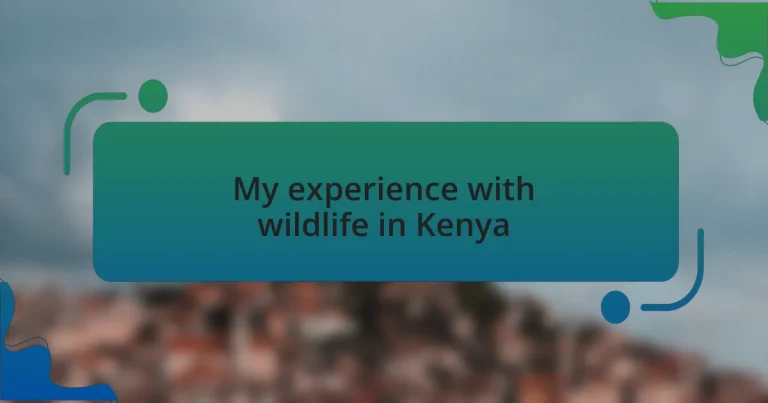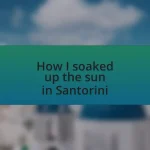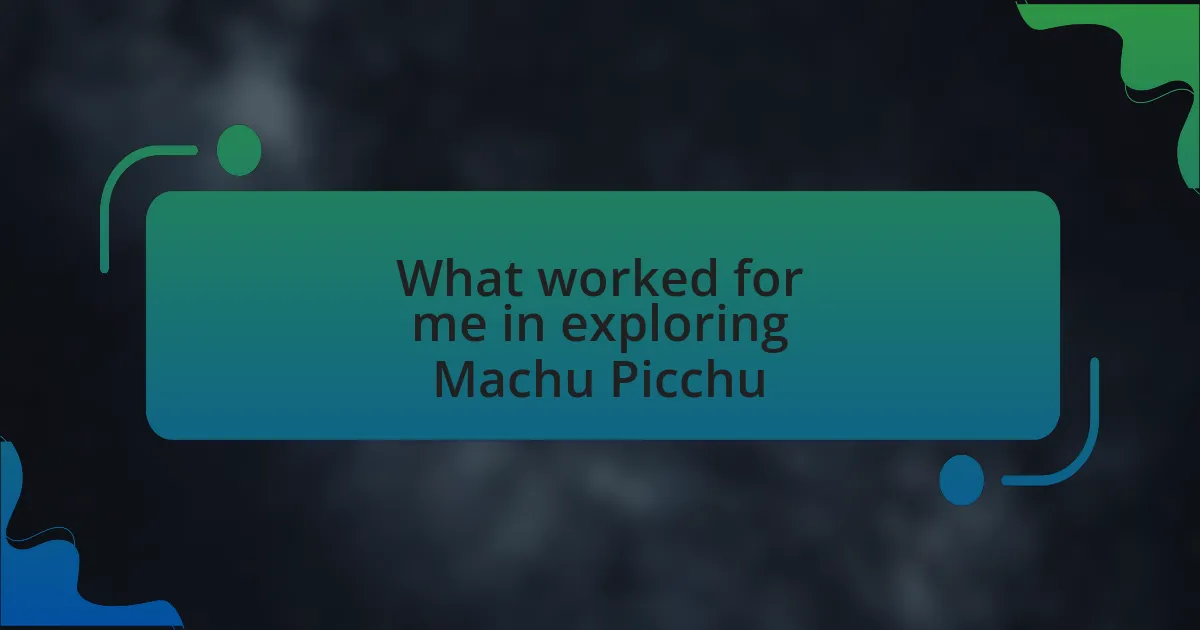Key takeaways:
- Wildlife travel blogging emphasizes storytelling and raising awareness about conservation efforts through personal experiences with animals.
- Firsthand wildlife encounters foster a deep connection to nature, igniting a passion for advocacy and conservation.
- Planning a Kenya safari involves understanding locations, timing, and selecting knowledgeable guides to enhance the experience.
- Photographing wildlife requires patience, an understanding of light, and a focus on capturing emotional connections with the subjects.
Author: Evelyn Hartley
Bio: Evelyn Hartley is a bestselling author known for her compelling historical novels that delve into the complexities of human relationships. With a background in literature and a passion for storytelling, she crafts richly detailed narratives that transport readers to different eras. Her award-winning debut novel, “Whispers of the Past,” was praised for its vivid characters and intricate plots. When she’s not writing, Evelyn enjoys exploring antique shops and researching the fascinating stories behind forgotten artifacts. She resides in a charming cottage in Vermont, where she draws inspiration from the beauty of nature and the stories it holds.
Understanding wildlife travel blogging
Wildlife travel blogging is not just about sharing stunning photos; it’s about connecting with the rich narratives of nature. I still remember the moment I first witnessed a pride of lions lounging in the savanna. The sheer grace and power of those animals left me breathless, which made me wonder—how do we convey such vivid experiences to our audience?
As I delved deeper into wildlife travel blogging, I realized the importance of storytelling. Each animal has a unique story, and capturing that narrative can be incredibly challenging. It was during one of my treks in Kenya that I stumbled upon a lone elephant, quietly grazing and seemingly wise beyond years. It struck me then—how can I encapsulate the emotion of that encounter, the majesty of the wild, in words that resonate with my readers?
Engaging with wildlife through blogging is also about raising awareness. I often ask myself: “How can my words inspire others to care for these magnificent creatures?” Sharing insights on conservation efforts and the threats faced by wildlife has become a crucial part of my journey. Reflecting on my experiences has shown me that every blog post could potentially spark curiosity and a desire to protect these animals for future generations.
Importance of wildlife experiences
Experiencing the wild firsthand can profoundly shift our perspective on nature and conservation. I recall the moment I found myself in the heart of the Maasai Mara during the great migration. Watching thousands of wildebeest tirelessly traverse the landscape made me realize how interconnected all species are. This experience not only deepened my appreciation for these animals but also ignited a passion within me to share their stories with the world.
Wildlife encounters often come with a sense of responsibility. After observing a mother cheetah teaching her cubs to hunt, I felt a surge of protectiveness for these vulnerable creatures. It dawned on me—how can we embrace our role as stewards of the earth if we don’t understand what’s at stake? Sharing these moments through blogging allows us to advocate for their existence beyond the page. I often think, what if my narrative of the wild inspires someone to take action toward wildlife preservation?
Being immersed in wildlife experiences fosters a personal connection not only with the environment but also with ourselves. There was a day when I sat quietly by a watering hole, watching a variety of animals come and go. Each one brought its own energy and spirit, and in that silence, I learned about patience and respect for nature’s rhythms. How do we harness such lessons in our everyday lives? The answer lies in sharing these transformative moments, ensuring that the beauty of wildlife is not just experienced but also cherished by everyone.
Planning your Kenya safari
Planning a safari in Kenya involves more than just booking flights and accommodations; it requires a thorough understanding of the landscape and wildlife. I remember tracing my fingers over a map, choosing between the vast savannah of the Serengeti or the rugged beauty of Amboseli. Each park offers a unique experience, and knowing where to go can mean the difference between an average trip and a breathtaking adventure.
When considering the best time to visit, I found that the dry season, from June to October, was particularly rewarding. I vividly recall sitting in a 4×4, the dust swirling around us as we located a pride of lions lounging under a tree, lazily watching the world go by. The thrill of those moments reminded me that timing can enhance your wildlife sightings and ensure a more memorable experience.
Additionally, I can’t stress enough the importance of choosing a reputable guide. During my safari, our guide shared fascinating insights about animal behaviors and local ecology that I never would have learned on my own. It made me wonder—how much could we gain from the right expertise, not just in terms of knowledge, but in creating a deeper connection with the environment we were exploring? Trust me, investing time in planning can make all the difference.
Best wildlife destinations in Kenya
One of my favorite wildlife destinations in Kenya is Masai Mara National Reserve. The immense plains teeming with life can truly be overwhelming. I distinctly remember the rush of spotting a cheetah sprinting across the grass, its sheer grace making my heart race. Have you ever experienced such excitement when witnessing nature in action? That feeling of being part of something greater is unparalleled.
Another remarkable spot is Amboseli National Park, famous for its stunning views of Mount Kilimanjaro. I was captivated by the sight of elephants roaming freely against the backdrop of the mountain; it felt like a postcard come to life. The sheer size of these gentle giants reminded me of the delicate balance of life in the wild and how our actions impact their future. Isn’t it incredible how close we can get to such majestic creatures?
Lastly, I can’t forget my time in Lake Nakuru National Park, where I marveled at the vibrant pink flamingos dotting the shoreline. The sight was surreal, almost like stepping into a dream. It struck me how every destination in Kenya offers a unique perspective on wildlife, encouraging us to appreciate both their beauty and fragility. What moments have left you in awe of nature? In Kenya, those moments seem to multiply at every turn.
Personal encounters with Kenyan wildlife
During my visit to the Masai Mara, one of the most memorable moments was watching a lioness grooming her cubs under the shade of an acacia tree. It was a simple yet intimate scene that really hit home the tenderness of wildlife, contrasting the harshness of survival in the wild. Have you ever found yourself captivated by a moment that revealed the softer side of nature?
Another experience that stands out occurred at Amboseli when I found myself surrounded by a herd of elephants. They moved with an elegance that belied their size, and I couldn’t help but feel a deep respect for their intelligence and social bonds. Standing there, I realized how powerful connections in the animal kingdom can mirror our own relationships, plunging me into reflection about the importance of family within both human and wildlife communities.
Then there was the afternoon in Lake Nakuru where a sudden rainstorm cut through the tranquility, sending birds scattering in all directions. In that chaotic moment, I laughed and ran for cover, realizing that even in nature’s unpredictability, there’s beauty to be found. Have you ever been swept up in a wild moment like that? It’s in those unpredictable experiences that we often find the most profound connections with the world around us.
Tips for photographing wildlife
Capturing wildlife in Kenya can be a thrilling yet challenging experience. One tip I can share from my adventures is to be patient. I remember waiting silently in a vehicle for what felt like hours as a pride of lions gradually emerged from their slumber. Just when I thought nothing would happen, the lead lion stood up, stretched, and sauntered right past us. This moment taught me that the art of wildlife photography hinges on quiet anticipation.
Timing and lighting also play crucial roles. During my early morning drives, the golden rays of dawn accentuated the silhouettes of elephants against the horizon. It’s a magical sight that brings out the intricate details of their wrinkles and dusty skin. Have you ever noticed how different light can transform a scene? Understanding that change can elevate your photos from ordinary to extraordinary.
Lastly, focus on the eyes of your subject. There’s something profoundly captivating about capturing the gaze of a wild animal. I recall taking a close-up shot of a curious giraffe as it peered down at me, its big eyes full of wonder. That connection speaks volumes and can evoke an emotional response in anyone who views the photo. Have you ever experienced a moment where an image seemed to come alive? These interactions are what make wildlife photography so deeply rewarding.
Reflections on my wildlife journey
Reflecting on my wildlife journey in Kenya, I often find myself lost in the vivid memories of those unexpected encounters. One moment that stands out was when I stumbled upon a herd of wildebeests crossing a river. The sheer determination on their faces as they braved the rushing waters struck a chord with me. It made me ponder: have we ever faced challenges that felt insurmountable, only to find the strength to push through?
Another unforgettable experience was watching a cheetah sprint across the savannah. The raw power and elegance of that creature left me breathless. In that split second, everything else faded away, and I was enveloped by a sense of awe. How often do we give ourselves the chance to appreciate pure beauty in motion? Moments like this remind me of the wild’s ability to evoke intense feelings of both humility and gratitude.
The connections I formed with the land and its inhabitants were equally profound. I remember sharing silence with a magnificent elephant, standing just a few feet away. In that stillness, I felt a connection beyond words, a whisper of understanding that transcended the barriers between our worlds. Isn’t it amazing how wildlife can teach us lessons about respect and coexistence? Each experience I had in the wild carved a deeper appreciation for the delicate balance of nature, leaving me forever changed.




